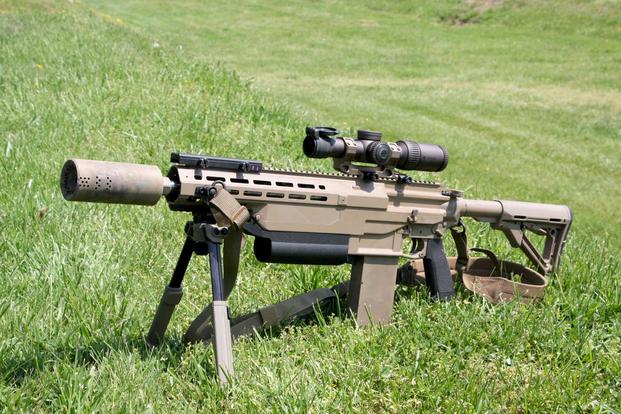The U.S. Army on Monday unveiled its $178 billion spending request for fiscal 2021, a proposed budget that adds some 1,000 active-duty soldiers and sets aside money for new long-range missiles, high-tech soldier systems and a new family of rifles for infantry and other close-combat forces.
The $178 billion topline request is $4 billion less than last fiscal year's $182 billion request, according to Army budget documents. The Army received $180 billion in the fiscal 2020 enacted budget.
Related: Army Slashes Old Programs to Fund New Tech in 2020 Budget Request
The Army is requesting $62.5 billion for military personnel, including $45.1 billion for the active force, a $2.4 billion increase over the $42.7 billion it received last year, according to budget documents.
Despite the increase, the Army is projecting modest growth, adding 900 active-duty soldiers to its ranks and transferring another 100 new active-duty soldiers for the new United States Space Force.
By the end of fiscal 2021, the Army plans to reach an end strength of 485,000, according to the documents.
The Army met its fiscal recruiting goals in fiscal 2019 after struggling to recover from a troubling 6,500-person recruiting shortfall the year.
The National Guard is slated to receive $8.8 billion for 336,500 soldiers, an increase of 500 from last year, according to budget documents. The Army Reserves is set to receive $5.1 billion for 189,800 soldiers, an increase of 300 soldiers from last year under the request.
The Army is also requesting funding for significant investments in soldier lethality, another modernization priority.
The Next Generation Squad Weapon -- a new 6.8mm system slated to replace the M4A1 carbine and M249 squad automatic weapon in infantry squads -- is slated to receive $111.2 million -- that's $75.4 million for RDT&E and $35.8 million to start buying the first rifle and automatic rifle variants, according to Pentagon budget documents. Fielding is scheduled to begin in fiscal 2023.
The Army also plans on spending $906 million for 40,219 sets of Integrated Visual Augmentation System (IVAS) -- a Microsoft-based system that features sophisticated goggles that allow soldiers to see their weapon sight reticle in their field of view along with other key tactical information. Fielding is set to begin in fiscal 2021.
The Army continues to place a high priority on its modernization effort, a plan to replace most of its major weapons platforms over the next decade.
The budget request realigns $9 billion in the fiscal 2021-2025 Program Objective Memorandum (POM) to fund its cross-functional team development efforts.
Army leaders "eliminated 41 programs and reduced/delayed 39 programs across the [Future Years Defense Program] not tied to the [National Defense Strategy] or modernization priorities," according to budget documents.
The Army began ruthlessly cutting non-modernization programs in the last budget cycle to free up more than $31 billion in a tedious process known as "Night Court."
"We must transform all linear industrial age processes to be more effective, protect our resources and make better decisions," Army Chief of Staff Gen. James McConville, said in the documents. "We must be the Army of tomorrow, today."
The Army is making cuts to procurement of weapons and tracked vehicles, requesting $3.7 billion compared to the $4.7 billion it received last year, according to budget documents.
The Army cut buys of the Armored Multi-Purpose Vehicle, purchasing 32 vehicles for $193 million. Last Year, the Army bought 21 for $445 million, according to Pentagon budget documents.
The budget requests $894 million for Joint Light Tactical Vehicle (JLTV). Last year the Army received $972.4 million, according to budget documents. The Army announced last year that it planned to slow down its purchases of JLTVs to free up money for modernization.
The Army also cut military construction, requesting $1.1 billion, down from the $1.8 billion it received last year. The request includes $650 million for nine projects in the active-duty force. That's a decrease from the $1.4 billion the service requested for 21 active Army projects in fiscal 2020, according to budget documents.
The National Guard is slated to receive $321 million for 18 projects, according to budget documents. The Reserve would get $88 million for four projects.
The Army increased its missile budget to $3.5 billion, up from the $3 billion it received from last year, according to budget documents.
For long-range precision fires, the Army's top modernization priority, the service is requesting $800 million in research, development, testing and evaluation (RDT&E) for the Long-Range Hypersonic Missile effort, according to budget documents.
The Army is requesting a total of $172.6 million for its new, long-range Precision Strike Missile (PrSM). Some $122.7 million of that is for research, development and testing and $49.9 million would purchase 30 of the new missiles, according to Pentagon budget documents. The PrSM is intended to engage targets beyond 500 kilometers, replacing the Army Tactical Missile System (ATACMS) which has a range of about 300 kilometers.
The Army is spending $537 million for the Mobile Short-Range Air Defense System, or M-SHORAD, compared to last year's $233 million, according to budget documents.
-- Matthew Cox can be reached at matthew.cox@military.com.
Read More: Army to Cut JLTV Buy to Pay for Future Systems
Don't Miss a Single Military.com Story
To read the full article and get exclusive benefits, sign up today.
It’s FREE
Why am I seeing this? Visit our FAQs













